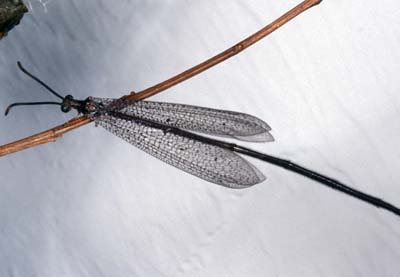
Adult Brachynemurus longicaudus, an antlion.
(Photographer: Lyle Buss, University of Florida)
Males and females of the same species are similar in appearance. Adult antlions resemble damselflies, but they have softer bodies, a lacy wing pattern, and long clubbed antennae. Antlions also resemble owlflies, but their antennae are only about as long as the head and thorax together, while the antennae of owlflies are nearly as long as their bodies. The bodies of antlions are long and slender, and grayish in color. The wings are generally clear, but some species have spots on their wings. Antlions are weak fliers and can be found at night near lights. Antlion larvae have rounded bodies with long sickle-shaped jaws. The larvae are found at the base of cone-shaped pit in sandy areas. Pupation occurs in silken cocoons covered with grains of sand.
Antlions usually remain in the larval stage for one to two years depending on the species. Once they pupate, they require up to one month to complete their development. Adult antlions survive for one to two months.
Antlions are found all over the United States in various habitats.
The larvae of antlions are ferocious predators that feed on many small insects (such as ants) and some spiders.
Images
To save the Web-optimized images shown below to your hard drive:
|
Click to access Display and Print quality images. |
|
Click to access Display and Print quality images. |
|
Click to access Display and Print quality images. |
|
Click to access Display and Print quality images. |